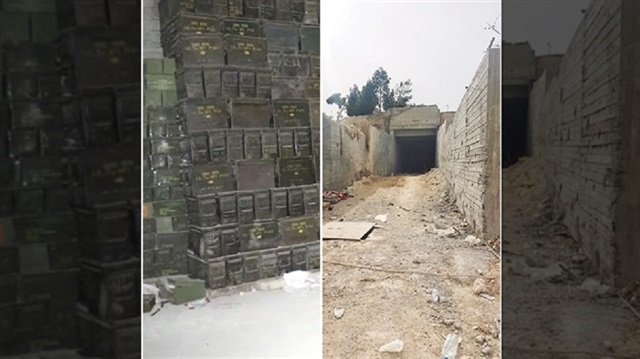
Giant underground armory filled with arms and munitions from multiple countries discovered amid Operation Olive Branch
An armory consisting of 13 chambers in line with NATO standards was unearthed in Afrin’s city center, which was captured by the Turkish Armed Forces (TAF) and Free Syrian Army (FSA) early on Sunday as part of Operation Olive Branch, which was launched on Jan. 20 to clear the area of YPG/PKK-Daesh terrorists.
The TAF and FSA are continuing to detect the terrorist organization’s tunnel networks and armories. A giant armory located just outside Afrin on the skirts of a hill and covered in olive trees was spotted.
Yeni Şafak daily obtained exclusive footage of the armory, which stowed advanced arms and munitions including TOW missiles, SUV-23 munitions, DShk heavy machine guns and mines.

Built underground and of thick concrete walls, the armory was designed according to NATO standards. It is about 200 square meters in size and has 13 chambers. Trucks can easily enter.
Ventilation vents are spread across the ceilings and there are cages that prevent birds from entering, in addition to reservoirs on the ground that collect rain water. The armory would require planning and engineering skills beyond that of a terrorist organization.
Yeni Şafak and TVNET Editor-In-Chief İbrahim Karagül was among the first journalists to enter the armory.
“What we saw really surprised us. It is clear that the preparations being made were not to defend Afrin. This building was not prepared as an armory for the terror group, and it is proof that countries who back terror were preparing not only for Syria,” said Karagül about the armory.

“Preparations for conflict within NATO were made. An important portion of military planning methods of NATO against Turkey, which is a NATO member, were implemented here. What we saw is proof that this preparation was against Turkey,” he added.
Karagül also described the vast array of arms and munitions inside the armory.
“For the first time, it is possible to see massive buildups [of arms and munitions] inside an armory that was viewed by a journalist. We saw advanced weapons including TOW missiles, SUV-23 munitions, DShk heavy machine guns and mines stashed away in hundreds of chests, barrels and cases,” said Karagül.

The source of the millions of stashed bullets found in the armory can be traced to multiple countries, however the majority are made in the United States.
“In addition to Russian weapons and ammunition, there are munitions that point to the Syrian regime and have text in Arabic on them. There are also Iranian guns and ammunitions stored in another chamber,” said Karagül.
“This underground armory in no way holds the munitions of a terror group. Everything from the construction of the armory to the variety and type of the ammunition was prepared for a war between states,” he added.

“The two metal chests we saw were constructed in accordance with NATO standards, and the fuses inside were again protected in accordance with NATO standards. The extent of the international operation Turkey’s Afrin op dealt a blow to can be seen by looking at this underground armory,” said Karagül.
“Afrin was going to be decked with an army of thousands and the greatest evidence of the arms and munitions shipments is this armory that spans underground like a metro line. Despite international support, the PKK/PYD and the forces among them fled and left behind their weapons without resisting the TAF and FSA,” he added.
Afrin has been a major hideout for the PYD/PKK since July 2012, when the Assad regime in Syria left the city to the terror group without putting up a fight.
The U.S has supplied the PKK/PYD terror organization with more than 5,000 truckloads of weapons to allegedly use in the fight against Daesh, despite Ankara’s warnings that the group is the Syrian offshoot of the PKK terror organization.
The PKK is listed as a terrorist organization by Turkey, the European Union and the United States. The PKK has been conducting armed violence in the southeastern part of Turkey since 1984. More than 40,000 people, mostly civilians, have been killed in the three-decade long conflict.








